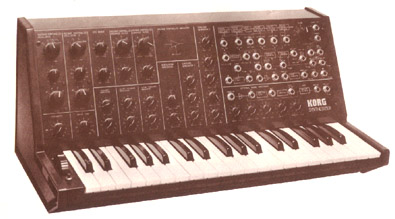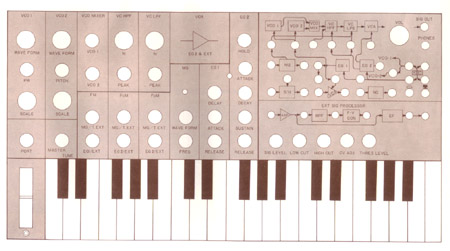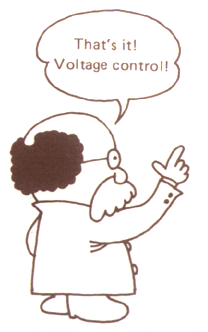First of all:
If you find this web page useful, please help us keep it running by clicking on
our three sponsors above. They just open a page in a new window, nothing more
harmful than that. You can close the new window if you are not interested in
it, and you will return here. Thanks for visiting!

Here are some pictures of one of my Korg MS-20 synthesizers. The MS-20 is a patchable monophonic synthesizer which appeared in 1978. It has two VCOs, one with variable pulsewidth and one with ring modulation, two VCFs (one highpass and one lowpass, both with resonance), a VCA in the audio path, two envelope generators, an LFO, a noise source, a separate VCA, a separate external signal processor, a wheel controller, and a trigger button.
There are internal connections forming a standard VCO-VCF-VCA audio path, so it's not a totally modular synthesizer. This audio path is affected by several modulation routings from the envelope generators and the LFO. However, there is also a large patch-panel with 35 jacks that can be used to make interconnections between the various parts of the synthesizer and even override some of the internal connections. It is of course also possible to involve other signal-generating or signal-processing equipment. So, it is very easy to make sounds by subtractive synthesis in a standard manner using the internal connections, as well as make very complex patch-cord connections resulting in sounds similar to those from large modular synthesizers.
The detail that most of all gives the MS-20 its very special tonal character is without a doubt its filters. The lowpass filter in itself is just a two-pole (that is 12 dB/octave) filter, but together with the highpass filter and the possibility to add resonance to both of them, as well as to modulate them with almost anything, it is a really unique sound-creation tool.
The external signal processor (ESP) provides a way of controlling the synthesizer by any external sound source, for example a human voice or another synthesizer. It comprises an input amplifier, a variable bandpass filter, a frequency-to-voltage converter for pitch tracking, an envelope follower, and a trig extractor. For instance, the MS-20 can be played by a MIDI synthesizer or a guitar, or its own noise source can be used to create randomly distributed pulses that can be used to trig envelopes in a very special manner.
The MS-20 has several sisters in the patchable Korg family of the late 70's: the MS-10 and MS-50 monophonic synthesizers, the VC-10 vocoder, and the SQ-10 analog sequencer, which are designed to match each other visually as well as electronically; but also the all-polyphonic monsters PS-3100, PS-3200 and PS-3300 .
For more info about the Korg MS-20, see for example the appropriate pages at Vintage Synth Explorer, the one at The Virtual Synthesizer Museum, or take a look at the Vintage Korg Page, or perhaps Sonic State Synt Site .
More technical info, including the service manual, is available - AS ALWAYS - on the wonderful Music Machines .
And by popular demand, here is a link to the owner's manual!
Now, since you have read all the way here:
Please help us keep this web page running by clicking on our three
sponsors links below. They just open a page in a new window, nothing more
harmful than that. You can close the new window if you are not interested in
it, and you will return here. Thanks for visiting! :-)


Left side of the front panel

Right side of the front panel

The rear side. Note the metal ID plate from the Swedish distributor - in fact
the only place where the name "MS-20" appears!

Beautiful international warning on the back

The disadvantage of "safe" shipping - a synth full of styrofoam

Excerpt from the Owner's Manual: The blank patch sheet - fill in your own
patches!


Excerpt from the Owner's Manual: Wonderful illustrations of the waveforms and
pulse width

Excerpt from the Owner's Manual: Dr. Korg

